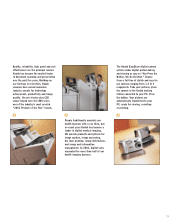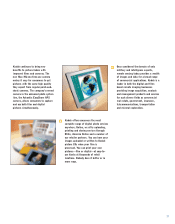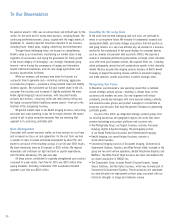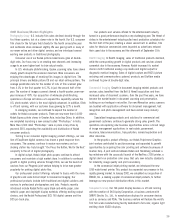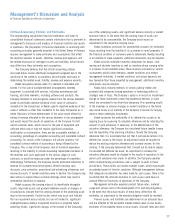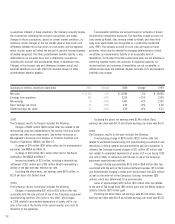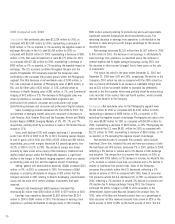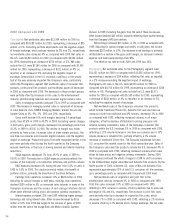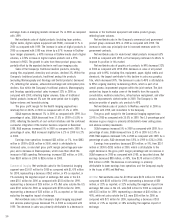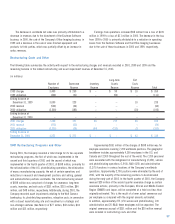Kodak 2001 Annual Report Download - page 29
Download and view the complete annual report
Please find page 29 of the 2001 Kodak annual report below. You can navigate through the pages in the report by either clicking on the pages listed below, or by using the keyword search tool below to find specific information within the annual report.
27
Management’s Discussion and Analysis
of Financial Condition and Results of Operations
Critical Accounting Policies and Estimates
The accompanying consolidated financial statements and notes to
consolidated financial statements contain information that is pertinent to
management’s discussion and analysis of financial condition and results
of operations. The preparation of financial statements in conformity with
accounting principles generally accepted in the United States of America
requires management to make estimates and assumptions that affect
the reported amounts of assets, liabilities, revenue and expenses, and
the related disclosure of contingent assets and liabilities. Actual results
may differ from these estimates and assumptions.
The Company believes that the critical accounting policies
discussed below involve additional management judgment due to the
sensitivity of the methods, assumptions and estimates necessary in
determining the related asset, liability, revenue and expense amounts.
Kodak recognizes revenue when it is realized or realizable and
earned. For the sale of multiple-element arrangements whereby
equipment is combined with services, including maintenance and
training, and other elements, including software and products, the
Company allocates to and recognizes revenue from the various elements
based on verifiable objective evidence of fair value (if software is
incidental to the transaction) or Kodak-specific objective evidence of fair
value if software is other than incidental to the sales transaction as a
whole. Revisions to these determinants of fair value would affect the
timing of revenue allocated to the various elements in the arrangement
and would impact the results of operations of the Company. For full-
service solutions sales, which consist of the sale of equipment and
software which may or may not require significant production,
modification or customization, there are two acceptable methods of
accounting: percentage of completion accounting and completed contract
accounting. For certain of the Company’s full-service solutions, the
completed contract method of accounting is being followed by the
Company. This is due to the Company’s lack of historical experience
resulting in the inability to provide reasonably dependable estimates of
the revenues and costs applicable to the various stages of such
contracts as would be necessary under the percentage of completion
methodology. Furthermore, the Company records estimated reductions to
revenue for customer incentive programs offered including cash
discounts, price protection, promotional and advertising allowances and
volume discounts. If market conditions were to decline, the Company may
take actions to expand these customer offerings which may result in
incremental reductions to revenue.
Kodak assesses the carrying value of its identifiable intangible
assets, long-lived assets and goodwill whenever events or changes in
circumstances indicate that the carrying amount of the underlying asset
may not be recoverable. Certain factors which may occur and indicate
that an impairment exists include, but are not limited to: significant
underperformance relative to expected historical or projected future
operating results; significant changes in the manner of the Company’s
use of the underlying assets; and significant adverse industry or market
economic trends. In the event that the carrying value of assets are
determined to be unrecoverable, the Company would record an
adjustment to the respective carrying value.
Kodak maintains provisions for uncollectible accounts for estimated
losses resulting from the inability of its customers to remit payments. If
the financial condition of customers were to deteriorate, thereby resulting
in an inability to make payments, additional allowances may be required.
Kodak provides estimated inventory allowances for excess, slow-
moving and obsolete inventory as well as inventory whose carrying value
is in excess of net realizable value. These reserves are based on current
assessments about future demands, market conditions and related
management initiatives. If market conditions and actual demands are
less favorable than those projected by management, additional inventory
write-downs may be required.
Kodak holds minority interests in certain publicly traded and
privately held companies having operations or technology within its
strategic area of focus. The Company’s policy is to record an impairment
charge on these investments when they experience declines in value
which are considered to be other-than-temporary. Poor operating results
of the investees or adverse changes in market conditions in the future
may cause losses or an inability of the Company to recover its carrying
value in these underlying investments.
Kodak evaluates the realizability of its deferred tax assets on an
ongoing basis by assessing its valuation allowance and by adjusting the
amount of such allowance, if necessary. In the determination of the
valuation allowance, the Company has considered future taxable income
and the feasibility of tax planning initiatives. Should the Company
determine that it is more likely than not that it will realize certain of its
deferred tax assets in the future, an adjustment would be required to
reduce the existing valuation allowance and increase income. On the
contrary, if the Company determined that it would not be able to realize
its recorded net deferred tax asset, an adjustment to increase the
valuation allowance would be charged to the results of operations in the
period such conclusion was made. In addition, the Company operates
within multiple taxing jurisdictions and is subject to audit in these
jurisdictions. These audits can involve complex issues, which may require
an extended period of time for resolution. Although management believes
that adequate consideration has been made for such issues, there is the
possibility that the ultimate resolution of such issues could have an
adverse effect on the results of operations of the Company.
Management estimates expected product failure rates, material
usage and service costs in the development of its warranty obligations.
In the event that the actual results of these items differ from the
estimates, an adjustment to the warranty obligation would be recorded.
Pension assets and liabilities are determined on an actuarial basis
and are affected by the estimated market-related value of plan assets,
estimates of the expected return on plan assets, discount rates and other




